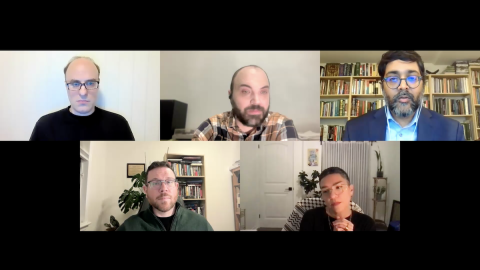Teaching in the Shadow of Conspiracy Theories
Some years ago, a high school history teacher I know told me that he had received an essay that supported Holocaust denial. The student, who was told to use primary and secondary sources in his research, cited his grandfather. Grandpa had been in the army of an Eastern European country and had assured his grandson that the Holocaust was a hoax. He had seen Auschwitz. It had a swimming pool. It was actually like Club Med, reported Grandpa.
Shortly after September 11, 2001, again in a high school history class, a student told me that no Jews had been killed in the attacks on the Twin Towers in New York. According to this student, the “Jewish conspiracy” had sent out an alert on September 10th, ensuring that no one in the know went to work the next day. Her uncle had showed her an Arabic language news source that he believed was accurate and trustworthy.
These students lived and went to school in the days before social media. Today, teachers are hearing conspiracy theories that arrive so fast and furiously, that they barely know where to turn. QAnon? Pizzagate? COVID hoaxes? Vaccines that contain microchips? Climate change is a hoax? The moon landing is a hoax? Is there enough time in a day to deal with all the things that students believe, despite a lack of evidence or truth?
Let’s go back in time in order to get some perspective on what students and their families believe that may be contrary to what is taught in the curricula.
When did the curriculum begin to include astronomy rather than astrology? When did we start dismissing the people who believe the earth is flat? When did we stop teaching about phlogiston?
These questions are difficult, because beliefs are fluid. We know that not only points of view, but also facts taught in schools change over time. Curricula change when knowledge changes, and when we expand our understanding. This, however, takes time and patience.
The teacher who received the Holocaust denial essay did not accept it. Instead, he spent several weeks going to the library with the student, showing him the difference between bona fide and spurious sources. He explained that while the student’s grandfather may be a wonderful Grandpa, he is not an accurate historical source. The student was asked why he wanted to believe that the Holocaust had not happened despite what he was taught in his World History course. It turned out that the student had been approached by a skin-head white supremacy gang. He was a loner looking for community. The teacher spent considerable time with him discussing the social and psychological issues around joining such gangs. The second essay the student submitted reflected a better understanding of world history.
This teacher believed that no one should pass the course believing that the Holocaust was a hoax.
The second teacher, the one whose student believed that no Jews had died during 9/11, did nothing. She was concerned that she could be in trouble with the families of students who believed this false information. She did not want to engage.
Some people think that Facebook and Twitter, as well as other social media platforms, should be the ones to ban misinformation and conspiracy theories. Others want to see criminal penalties – Canada has anti-hate legislation – should it apply here?
Will any of this have an effect on what school aged students believe? Personally, I trust in time. Think of the people who are born into religious faiths they then go on to reject when they are older. Our parents’ morals may not be our own. Our parents’ values may differ from ours. When adolescents are learning, they are trying on different beliefs and ways of understanding the world. This is why we must be teaching learners to think critically.
It is possible to teach people how to check their sources of information, but it is not possible to teach them what to believe. Because we cannot prove a negative, teachers cannot show students that there are no Jewish space lasers, no deep state, nor lizard people who secretly rule the world.
The difficulty I have with the believers in ludicrous theories is that teaching in a democracy means we must protect their freedom of expression, as well. While many teachers would like to ban or at least ignore these absurdities, doing so tends to confirm and even to solidify such beliefs. “See, I told you my teacher is part of the conspiracy. She won’t even let me discuss the TRUTH.”
There is barely enough time in a school day to deal with the curriculum. It feels like a waste of time to go off into the clouds to talk about conspiracies. It is never wise to ridicule, belittle or humiliate a student for their beliefs, but it is also unwise to give them too much space. Perhaps secular schools can deal with conspiracy theorists the way many deal with creationists. We do not deny that some people believe God created the earth, we just don’t teach it in school. When we teach a theory of evolution, we remember that it is a theory – but the test will be on Thursday.

